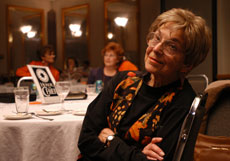Group hosts dinner to reflect on past Chiefs
November 11, 2004
Fund-raising calendars featuring the Chief sat beside Chief Illiniwek Coca-Cola longneck bottles; bumper stickers were stacked on tables next to DVDs. The tables were sprinkled with orange and blue stars.
The Honor the Chief society hosted a dinner reception last night to recognize the years of dedication put forth by University Chiefs and faculty supporting the symbol.
Gary Smith, band director from 1976 to 1998 and acting band director this semester, was the first speaker of the night.
Smith described the changes in the role of the Chief during his term as band director, including how the Chief used to serve as a public relations figure for the University and thus had a tough time keeping up with his schoolwork. Smith had the Chief’s duties limited to performing with the band.
Roger Huddleston, founder of the Honor the Chief Society, spoke about the Chief as a symbol of heritage and diversity.
Get The Daily Illini in your inbox!
“I think the Chief is the perfect symbol of diversity because he represents us all,” Huddleston said.
Huddleston described an American Indian activist in Montana who told former Chief Illiniwek Ben Forsyth about how his tribe is being devastated by alcoholism. Huddleston said the activist looks at the Chief as hope for the future because of the attention he brings to American Indian tribes.
“He said, ‘You guys look back on this as a reflection of the past’,” Huddleston said. “He said, ‘I look at him as a hope for my people for the future.'”
Huddleston said the Honor the Chief society is active in studying native Illinois tribes. One project the Society is working on is recovering the native language of the Peoria tribe. He also said they are working on a documentary for Illinois school children to learn about native Illinois tribal heritage.
“We’re human beings, we’re on this planet together. The Chief is the common ancestor to all of us,” he said.
Tom Livingston, Chief Illiniwek in 1988 and 1989, described the experiences he remembers most about performing as the Chief.
He described sneaking through the marching band, surrounded by orange and blue, his ears ringing from the sound of the band – the loudest sound he’d ever heard. As he would get to the edge of the band, he’d begin to see streams of sunlight shine through, then would rush forward and would feel like he was running off the edge of a cliff and spreading his wings.
He’d turn toward the crowd and lift up his arms, as the fans sang the Alma Mater. He said he could feel energy come up through his toes and his sides.
“I couldn’t tell you if I was in shock or just emotional,” Livingston said.
He said he still dreams about it.
“It’s something you carry on with you,” Livingston said of being a part of the tradition.
Livingston, who has visited the Peoria tribe in Oklahoma, said he asked a Peoria chief if the dance was disrespectful. He said the Peoria chief responded by saying the Chief is unto itself.
The current Chief, Kyle Cline, was the final speaker for the night.
“To see this kind of support I see here is unbelievable,” Cline said. “Let’s make sure generations understand the beauty and majesty that is the Chief Illiniwek tradition.”
Cline went on to say he realized there are groups of people that are truly hurt by the image of the Chief. He believes pursuing open dialogue can help people come together.
Huddleston said the Chief is more than just a symbol.
“(The Chief) celebrates the human race, reaches the underserved of our community and of our world and is an ambassador of higher learning,” Huddleston said.







